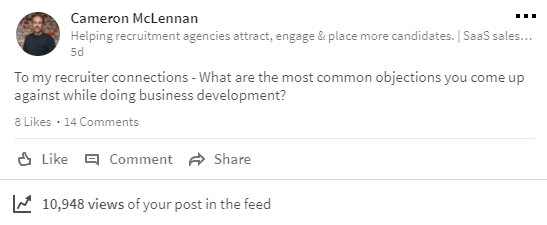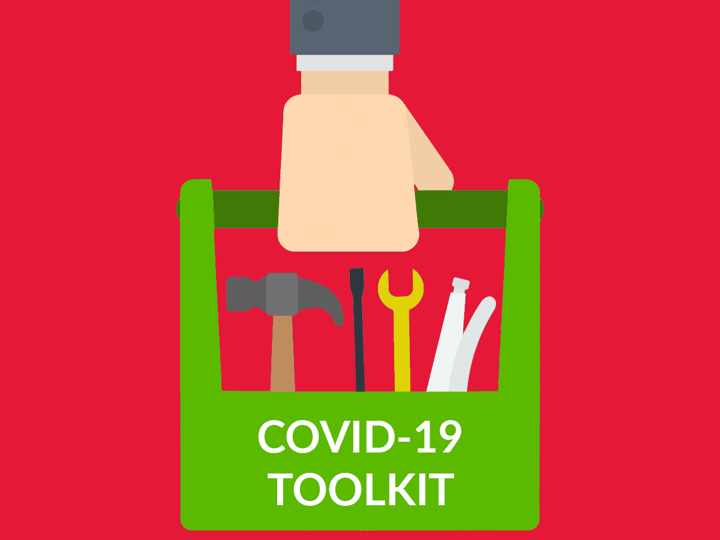We recently had a chat in the office about sales objections recruiters frequently face. So, we decided to put together a blog covering some of the most common alongside some tips and advice on how to handle them. Read on to discover our three-part process designed to help you overcome any and all objections you’ll encounter as a recruiter…
To get a better understanding of the typical objections recruiters face day in, day out I put a comment on LinkedIn asking:

And the results on the post were great. Here’s what my network frequently comes up against:
- We’re using another agency
- You’re too expensive
- We have a PSL already
- We’re not recruiting
- We do the recruiting ourselves
- We use job boards
- HR are responsible for that i.e. it’s not my job
- We’ve got no budget
- I’m too busy to talk right now
- We’re too small to use an agency
- Our business is too technical
Plus a few others that I can’t repeat in a blog 😊. But it’s likely that you’ve encountered most (if not all) of the objections mentioned above. So, here’s a process that can be used to overcome each one of the objections listed:
3 Step Process for Handling Sales Objections
- Encourage, probe, and probe some more
- Confirm and provide a response
- Check
Let’s look at this process and consider each step in more detail…
Step 1: Encourage, Probe, and Probe Some More
When you get any objection, your first instinct is to talk about the ROI of your offering. And that makes sense - but it’s still too soon for a business case. The first thing you should do is “encourage” the objection and ask the prospect some probing questions.
You need to probe deeper into the objection and encourage your prospect by saying, “Tell me more about that. Why do you have this concern?" At this stage, the goal is to keep the conversation moving. When the prospect gets to the end of the issue, ask “What else?” and stay quiet. Often it is the answer to that last "What else?" that contains the biggest barrier to moving the chat forwards.
Tackling the objection like this builds your credibility. When you start defending yourself (“Fiona, let’s look at the big picture here and talk about ROI”), you are often perceived as either not listening (best case) or trying to manipulate the person (worst case).
Encouraging and questioning, on the other hand, makes you seem confident and unafraid. It also helps you understand the real objection alongside your prospect’s specific concerns.
Step 2: Confirm and Provide a Response
Once you’ve asked one or two clarifying questions, restate the objection. This is called “confirming.” Showing you’re listening further enhances your credibility; plus, you implicitly get permission to move to the next step in the conversation.
Here, your objective is to justify your offering and help your prospect prioritise this. You might begin by acknowledging the real short-term budget impact and then build urgency by demonstrating the longer-term ROI you can bring by getting the right talent now. Long-winded responses can seem insincere, so keep your responses clear and to the point.
Now you have provided a case for why your offering is attractive, alongside a sound business case for investing in you and your agency.
Read: 4 Ways to Boost Confidence to Increase Prospecting Success
Step 3: Check
You have provided a response to the objection, but you’re not done yet. Great recruiters do one more thing: They “check.” This step surfaces any lingering reservations and reinforces the progress you’ve made.
Once you've responded to the objections, check if you've satisfied all their concerns. Just because they agreed with your response doesn't mean they’re sold on everything you said. Ask if they are happy with your offering and explain it further if necessary.
If the prospect isn't ready, don't try to force a commitment. Don’t accept a lukewarm "yes" for an answer either. Many prospects will accept a solution in the moment, but once you're out of sight or off the phone, the objection still remains. So, make sure they’re completely sold before closing the deal.
Conclusion
This 3-step process can be applied to any objection you might come up against while doing BD as a recruiter. A great exercise here is to spend a couple of hours with your colleagues, write down the most common objections that you face day to day then work through these steps, planning how you will handle each, working together to come up with the questions you would ask. The next time you are given an objection, slow down, pause and listen closely. BD should be a two-way conversation not a one-way barrage.
Cameron McLennan
Cameron McLennan works within recruitment technology industry. Outside of work, he loves spending time with his family and playing golf.




